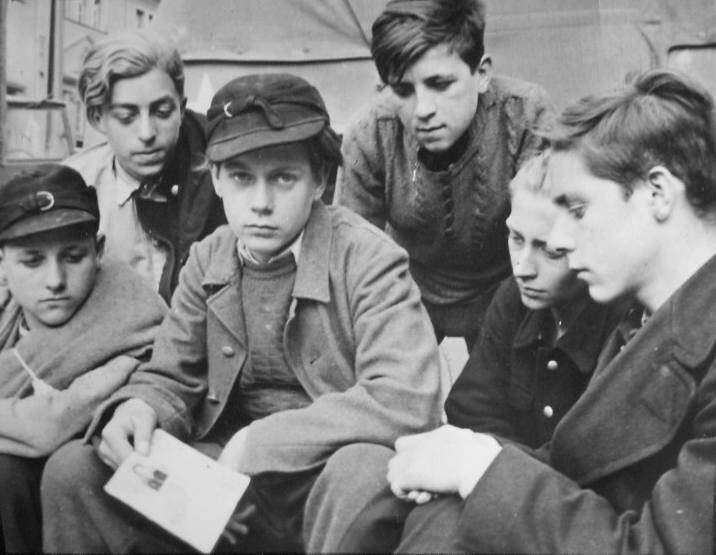
German Air Defenses: Flak Personnel--Non-Luftwaffe Personnel

Figure 1.--This Acme press photograph was captioned, "Sorrowful six: These German boys, all members of the Hitler Youth, were captured bu U.S. First Army Troops. Their ages ranging between 14 and 15 years, the six boys were being trained as glider pilots and anti-aitctadt gunners. Each boy possessed a soldier's pay book, which one of them displays." We're not sure why they are not wearing their uniform. The Luftwaffe had by April 1945 developed a new jet plane that could be massed produced and was easier to fly than the ME-262. Had the war lasted longer thesr jets would jave been flown by the HJ boys like this who had completed their glider training.
|
|
As the War began to go against Germany, more and greater demands were made on the Luftwaffe. Thus it was no longer possibe to use Luftwaffe mnen to man the massive ahti-aircraft batteries massed around major cities. the Germans began to replace active duty Luftwaffe personnel in the static batteries around the major cities targetted by the Allied strtegic bombing campaign. The FLAK batteries continued to be operated by the Luftwaffe, but Luftwaffe personnel were replaced by older men in the Home Guard, youth in the Reich Labor Service (RAD), and Hitler Youth (HJ) boys and girls. This required training and the 88s and other abti-aircraft guns were sophisticated weapons. There were a variety of other personnel involved, including Italian, Hungarian, and Russian POWs. (Italy and Hungary were NAZI allies, but Germany occupied Italy (1943) and Hungary (1944) ehen those countries attempted to leave the War. Women auxiliaries were also involved. We are not sure at this time as to the relative importance of these various groups. We know that the HJ was very important. Some like the Hitler Youth boys would have only been employed within the Reich close to their homes. We are not entirely sure who was manning the guns in many available images. Some show youths in both civilian clothes and Wehrmacht uniforms. The boys here are not wearing Whermacht uniforms or their HJ pins.
Lufwaffee Personnel
As the War began to go against Germany, more and greater demands were made on the Luftwaffe. Thus it was no longer possibe to use Luftwaffe mnen to man the massive ahti-aircraft batteries massed around major cities. the Germans began to replace active duty Luftwaffe personnel in the static batteries around the major cities targetted by the Allied strtegic bombing campaign.
Civilians
The FLAK batteries continued to be operated by the Luftwaffe, but Luftwaffe personnel were replaced by a range of civilians, including youth and oldermen. Battlefield losses and the growing Allied armies frivinhg toward the Reich meant that all available men of military age had to be mobilized for front-line combat. As a result, as the 6th Army was beginning to surrender in the Stalingrad pocket, the Luftwaffe began a major shift in the manning of FLAK batteries (January 26, 1943). Hitler Youth boys from that date would play a major role.
Training
RAF Bomber Command intensified the strategic bombing campaign when the new Lancasters behan to become acailable. Bpmber Command stahed the first thousand-bomber raid which struck at Cologne (May 1942). This was some thecLuftwaffe even using smaller bombers never managed. The Germans in that same month were unable tio strke back with similar force. They did, however, create the the Wehrertüchtigungslager (Defense Strengthening Camps--WELS). This was a 3 week mandatory training for boys aged 16 to 18 conducted by the Wehrmacht. At the time boys under 18 years of age were not ekugible for conscription. They werectaught how to use German infantry weapons including various pistols, machine-guns, hand grenades and Panzerfausts (hand hekd anti-tank rickets). The 88s and other anti-aircraft guns used in the FLAK batteries were much heavier weapons. As far as we know, the required training was given on the job when the boys reported to the FLAK batteries.
Groups Employed
The groups employed to man the FLAK batteries included older men in the Home Guard, youth in the Reich Labor Service (RAD), and Hitler Youth (HJ) boys and girls. There were a variety of other personnel involved, including Italian, Hungarian, and Russian POWs. (Italy and Hungary were NAZI allies, but Germany occupied Italy (1943) and Hungary (1944) ehen those countries attempted to leave the War. Women auxiliaries were also involved. We are not sure at this time as to the relative importance of these various groups. We know that the HJ was very important. Some like the Hitler Youth boys would have only been employed within the Reich close to their homes. We are not entirely sure who was manning the guns in many available images. Some show youths in both civilian clothes and Wehrmacht uniforms. The boys here are not wearing Whermacht uniforms or their HJ pins (figure 1). At first the HJ boys were assigned to FLAK batteries near their homes. At thecbombing intebsified, the Luftwaffe began transferring the boys all over the Reich, whereever they were needed. Younger HJ boys were assigned to operate search lights and communications duties. They riode their bicycles as dispatch riders. In one notable incident, a bomb struck a search light battery killing the entire crew of 14 year old boys (n October 1943). We have not yet found detailed statistics on casualties suffered by the FLAK batteries.
HBC

Navigate the Boys' Historical Clothing Web Site:
[Return to Main German flak personnel page]
[Return to Hitler Youth war service page]
[Return to Main German air defense page]
[Return to Main World War II Allied strategic bombing campaign page]
[Return to Main World War II air campaign war essay page]
[Return to Main World War II page]
[Introduction]
[Activities]
[Biographies]
[Chronology]
[Clothing styles]
[Countries]
[Bibliographies]
[Contributions]
[FAQs]
[Glossaries]
[Images]
[Links]
[Registration]
[Tools]
[Boys' Clothing Home]
Created: 10:03 PM 1/5/2009
Last updated: 5:47 AM 8/8/2012



